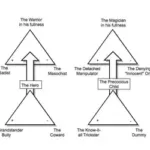 It is that time of year when we celebrate the birth of Jesus. Or at least that is the excuse we have to go all nuts with lights, chocolate, food and presents. In many ways Christmas has become the holiday of commercialism … which in one way is fitting as money is earth energy.
It is that time of year when we celebrate the birth of Jesus. Or at least that is the excuse we have to go all nuts with lights, chocolate, food and presents. In many ways Christmas has become the holiday of commercialism … which in one way is fitting as money is earth energy.
But what if we where to look under the hood of the tradition and see what actually is there. What if anything can we hold on to, what serves us at this point in time.
Return to the earth
So we need to return to the basics, the most base of all concepts to uncover what this time is all about.
Jesus is called the second Adam in scripture, this is to signify the utter humanity of Jesus and so the first part of this tradition is that it is a celebration of all that is human. In hebrew Adam means earth (or from the earth/earthling), the word human similarly is derived from the latin word ghomon, which means earthling or from the earth also connected the the word humus (earth).
Somewhere in our Christian tradition we switched our focus from earthly things to heavenly things, our focus became so strong that somehow we lost our roots, we lost our home and our origin.
Have you ever considered that none of the great Christian sacraments have prayer or meditation in the centre but rather mundane things like sex (marriage), Bathing (baptism), eating (eucharist) and burial.
At the beginning of all things the Christian story begins with dirt! We must never loose track of this as we reach for the heavens. Funnily enough the Christian story also ends with dirt, as a new earth is presented. It is all about the earth, the dirt and the land. So in one sense Jesus birth, brings us back to our humble (humble also from humus – down to earth) beginnings.
Birth
I thank god for the birth of Jesus. I mean the mythology is so breathtaking yet down to earth. He could just as well descended from heaven or just appeared (as he did in Marks gospel) But the fact that the gospel writers painstakingly and contradictory pen down this birth of a human baby makes all the difference.
As if god knew that unless we had a human birth covered in grime and blood we would truly loose our connection to the earth, to what is real. Apart from violent death I don’t there is anything quite as visceral as a birth. Even though we give birth in clinically clean hospital environments these days and we do everything in our power to clean it up births are messy affairs. Every bodily fluid imaginable is present, it is loud, it is smelly, it is grimy and it is dirty!
It is the true miracle of miracles, from conception to delivery there is nothing so powerful and magical as two human beings co-creating life through sacred union pregnancy and birth.
In the Christian tradition I contend that the birth of Jesus is the central event of the story. It is the ultimate declaration that the divine inhabits the earthly, the sacred in the human. No matter how much the Vatican tried to make the sexual disappear (immaculate conception) and clean up the story, it is and will always be a story that brings us from the celestial realm into a smelly stable late at night with screams of agony, visceral odours and blood!
Blood
The entire history of the world is steeped in blood and mystery. Just as the birth of Jesus. it is gory and grimy, no matter how much we want to clean it up it refuses our vain efforts to make it presentable. No religion is centred more in the blood mystery than Christianity. We sing it in the songs, “there is power in the blood”, “his blood has set me free” etc.
The Christian narrative starts with blood in that manger it hinges on the blood shed at the cross and has a blood red moon (the symbol of the goddess) at the end of all things. In the mean time our fellowships are more often than not centred around the drinking of the blood from the chalice.
The early church was so focussed on the eucharist that the Roman government officials declared the entire group a cannibalistic cult.
Interestingly we find that the word for human Adam is spelled in hebrew aleph-dalet-mem which means of the earth (Adamah means earth) but if you take away the aleph you are left with the hebrew word dam which means blood. Dirt and blood, what a potent mix add to that the breath of god, ruach the feminine spirit of god impregnating us with life.
Early mystical traditions talk about how we celebrate the divine feminine by drinking the life-blood from the chalice (the symbol of the feminine) and the gnostic gospel of Philip talks about Jesus drinking the mix of semen and life juice (menstrual blood?), from the Magdalene.
I know the late Jewish tradition (name P or the priestly traditions in biblical scholarshifringe scp) had a whole load of issues with moon-flow of women, they in fact had an issue with all bodily fluids. But the earlier narrative tradition is steeped in sacrificial language and blood mysteries.
Maybe it is time for us to reclaim this ancient wisdom and join with the fringe scientists who have discovered that the menstrual fluids of women have great healing powers, filled with stem cells that allegedly bestow anything fro youthful virility to the regrowing of hair.
Further on the mystical tradition claims that the spear stuck in Jesus side opened up a slit in Jesus side pouring out blood as a symbol of the bleeding woman. And this is why the same traditions hold that the chalice is the blood of the great mother, rejuvinating and vitalising us.
To reclaim this ancient and powerful wisdom we must first reclaim the divine feminine and to do that we need to return to the beginning.
Sexuality
It is funny how it always comes back to sexuality, my critics will say that for one with only a hammer every problem is a nail, but I realise that while it’s not at all about sexuality, it somehow always comes back to the sacred union, the cradle of all life.
You see in the beginning ….
Bereshit bara Elohim et hashamayim ve’et ha’arets. Veha’arets hayetah tohu vavohu vechoshech al-peney tehom veruach Elohim merachefet al-peney hamayim.
This beautiful verse filled with erotic tension and inuendo, the masculine and feminine juxtaposed in trembling anticipation of the co-creation of the manifest universe.
It is the beginnings (bereshit) when god began creating (bara) the heavens and the earth. The earth (erets) was chaos (tohu vavohu, a symbol of the feminine) and the depth (tehom) is calm (awaiting) The spirit of god flutters/trembles/moves over the waters (mayim, another symbol of the feminine).
Here the consciousness of god the masculine principle draws upon the chaos of the depth (the feminine raw energy) forming golden threads of light and life. The earth, the dirt is drawn out of the womb (tehom) of the mother creating the adamah earth and earthling the fruit of the first sacred union, from the dirt and the blood in an erotic dance (perichoresis).
The dance continues and the adama (earthlings) make love and co-create more life as instructed to fill up the earth. but it doesn’t end there, the divine is not done being sexual, the angels, manifestations of the divine will fall in love with the women of the earth and make love to them creating the nephilim (the giants) as if this isn’t enough we see procreation, co-creation and passionate lovemaking of the divine masculine and the divine feminine all around us.
But no place is it more poignant than when god joins with Mary in sacred union to produce Jesus (it does not matter, whether this is through Joseph, or another man or through god’s (feminine) spirit). Jesus is, however it happened technically the product of this sacred union of divine and human. The miracle of Christmas. Jesus co-creation of divine and human is born as a sign that we may know that while we come from dirt and blood we have a heavenly inheritance. And we come to this inheritance in the ecstatic sacred union.
So as we now take the sacrament, re-enact this mysterion this outward sign of the inward grace. We allow the flesh och the Christ penetrate us and become one with us and the blood of the divine to gently flow through us.








